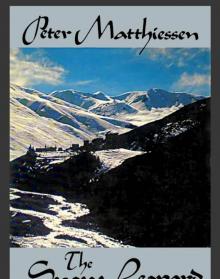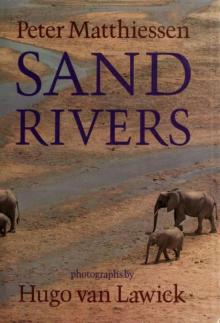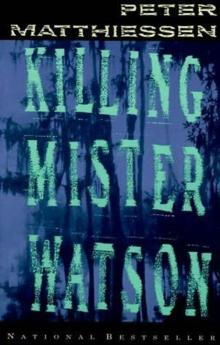- Home
- Peter Matthiessen
Men's Lives Page 5
Men's Lives Read online
Page 5
East winds made the sea unruly, but usually the seas took time to build; what was feared most was a sou’wester, which could come up suddenly and be blowing a whole gale before slow fish-laden boats out of sight of land could return to shore. Or sometimes there would be a heavy ground swell from an offshore storm, the men would feel its ominous lift under the boat. By the time they neared shore, these heavy swells would be breaking on the bar, a rise in the bottom about four hundred feet off the beach formed by the scouring action of longshore currents. (The bar may be eight feet below the surface, while the water inshore of it is eighteen or twenty feet deep.) Bill Lester and his father once got caught in a bad blow that nearly sank their boat when sea after sea broke over the stern as they slid down the faces of the waves.
“The main thing was to get across that bar and through the surf,” Francis Lester says. “You had to cross both, as the outer bar was breakin pret’ near constantly. When you got in the surf, you was a little bit nearer shore and you wasn’t quite as worried. If anything happened out there on the bar, you’d be in trouble because it would be hard for anybody to help you … But they used pretty good judgment most of the time—they had to, if they wanted to survive.”
“Surf fishin is a dangerous job,” Bill Lester says. “You take chances, and you have to know what you are doin. When there is bad weather and rough sea, the boat might turn over or she might fill up. You might get hit with the boat or the net might wash on top of you.
“One morning my brother Frank and I, we went down codfishing. There was quite a lot of sea out there, and we didn’t go because we had a gang of fykes in Montauk Lake, so we went down and lifted fykes. Young Nat Edwards and his cousin Kenneth hauled down, but it didn’t look too good, and they hauled back. For some reason they decided to haul down again, and they went off, took a bad sea, and filled the boat. That water was awful cold, and young Nat drownded. We set a codfish trawl around that spot, but the people on the beach pulled it in too quick and we never hooked him. Sometime later, Frank and I were settin trawl up here, maybe a mile west of where Nat drownded, and we seen somethin strange-lookin come up in a poose,3 just come up, y’know, and went down again; we rowed over there but we never saw nothin more. But a little later, another feller seen it again and pulled it out, and it was Nat. Wasn’t much left to him—all the top was gone, nothin left but his legs and up to his backbone a little bit. Funny thing was, still had his white socks on and no boots. We thought some way them boots must have come off him just a little while before we seen him in that poose.”
Kenneth Edwards told his younger brother Joshua, called Jack, that as they pushed off he had hollered to Nat, “Pull!” Kenny was standing in the stern of the small dory, pushing as Nat pulled on the same oars. When they cleared the first wave, Nat slacked up, getting his breath, and Kenny was turning to sit down beside him on the thwart (they would each take an oar) when they were struck by what the surfmen know as a freak sea—a big wave, out of the pattern of the others, that looms up quite suddenly out of nowhere. The boys swam back to the overturned dory, and this time Nat found footing on the false bar (a shallow bar that sometimes forms close to the beach) and stood up laughing. Kenny was yelling at him to kick his boots off when another sea struck him and he disappeared.
On one of the search parties along the beach, Jack Edwards found Kenny’s oilskin jacket at Ditch Plains, faraway east in the opposite direction. He speculates that his cousin Nat, unacquainted with the character of the false bar and the channel inshore of it, had attempted to wade in, and had sunk his boots in the soft sand on the false bar’s inner slope—“always quicksand on the inside of it,” Bill Lester says—and been dragged under. He must have been numbed by immersion in the icy water, and apparently he had no time to kick his boots off.
According to Milt Miller, who was close to the Edwards clan, the whole community was shaken by Nat’s death. “Cap’n Gabe’s son Cap’n Nat was a big trap fisherman down Montauk, and his son, young Nat, was my age. Young Nat hadn’t been brought up on the ocean, but worked the bay with his father; his cousin Kenny was the son of Cap’n Sam, and Kenny knew more about the bay than the ocean, too. There was quite a swell on, and we told ’em not to go. Why, we helped pull that boat back up to the dunes, and I went over Napeague to get some skimmer clams for cod bait.”
Francis Lester also recalls that the Edwards boys were inexperienced in the surf. That day Francis decided to “take off for Montauk and go oysterin, had a lot of oysters after Montauk Lake was opened up. But before I went, I went over there and told ’em, ‘Boys, that’s not very good weather, and if I was you, I wouldn’t try it.’ Well, they said they’d wait a while; sometimes it’ll calm down on a change of tide, y’know. And I said, ‘You better forget about it today.’ I took off and went oysterin, and they hung around, and the more they hung around, the more they thought it was gettin better. But it was still pretty rough, and they went forth, and they took a big sea. It threw the boat up and turned it over, and Kenneth got ashore, but the other boy, it was a long while before they found him.”
“We did everything we could to try to recover the body,” Milt Miller remembers. “The Lester Boys was there, too, draggin with cod hooks, but we couldn’t come up with him. I remember Cap’n Nat walking that beach every day, until finally parts of him come ashore, the head, one shoulder, all chewed up by crabs and sand fleas. Kenny Edwards was messed up in his head for quite a while after that, and I myself never went fishin for two or three weeks, because people were close-knitted in them times, and we took it hard.”
4.
The Return of
the Striped Bass
During the twenties, as oil-fueled ships replaced the old coal-burning steamers, the shore codfishery had declined, like shore whaling before it. The beam trawl had been replaced by the more efficient otter trawl,1 and huge draggers sent out by a Boston syndicate would take hundreds of tons of cod from a single area. Eventually ships were sailing all the way to Greenland to find cod in adequate numbers to support this new technology, until finally the cod syndicate went bankrupt.
With increasing pressure, the bunker hordes had also diminished, and one by one the fish factories closed down, from Hicks Island all the way around the bay to Greenport. The sturgeon grew smaller, then all but disappeared, and bluefish were extremely scarce, as they had been periodically since the eighteenth century. In 1908 they all but vanished, only to come back strong again in 1909.
No bluefish have been caught on the fishing grounds in Gardiners Bay this summer. Probably the oldest inhabitant does not recall a summer during his lifetime when some bluefish were not caught in the waters about the east end. It is told, however, as a fact, that over a century ago there was a period of fifty years in which not a bluefish was seen in these parts.
East Hampton Star, August 28, 1908
It is many years since there has been such fine bluefishing at the tide rip off Gardiners Point. The fish are there in great schools, acres of them, as far as the eye can see. Fluke are also extremely plentiful. There is scarcely a fishing boat that goes out but returns with a good load.
East Hampton Star, August 13, 1909
Bluefish were abundant once again in 1920–1921 but must have declined shortly thereafter, since Bill Lester says that “in the twenties, Harry, Frank, and Charles and me set gill nets in the ocean—that’s all we done. And bluefish was so scarce, you know, everybody was lined up for ’em. We got fifty cents a pound, sold every one, cause we only got one–two bushels a day. Then some years they disappeared altogether, couldn’t find a one.” Frank Lester recalled that no bluefish were caught for seven years.
As for striped bass, “When I was a boy, for a long long time, there wasn’t any,” Bill remembers. “Round about 1920, I guess, we made one haul and got sixty bass and that was big news all over the Island! First bass seen in a good while, and the last ones, too. So most of our fishing was set-netting in them days. Used to set about six gill nets in maybe sixteen foot
of water, between the outer bar and shore, each net forty-five fathom long. Set some in deeper water, too, back of the bar, cause that was safer. If you set between the surf and the outer bar, and you got a bad storm, might lose your nets or get ’em tore to pieces; no anchor’d hold ’em with that sea washing along. We would catch a lot of fish by setting off-and-on—one net straight off and then a wing along the beach, west in the spring, east in the fall. Could rig it different ways, y’know, with anchors to hold it against the set, maybe a hook in it to hold the fish in a kind of pen.Fish comin along would strike that net, turn offshore and hit the wing, or stay in the pocket till you come along and hauled. But settin off-and-on that way was dangerous, too, and we lost a lot of gear. One summer me and my youngest brother, Ted, lost eighteen nets, kept borrowin money at East Hampton Bank, come back with new nets, but the only one to make money was the twine company. So to get out of debt we went down Montauk to go dragging. We went about a year, done very good, and paid the bills off.
“Once I tried a month of plumbin with George Schellinger; he was my brother-in-law. Fishin was poor probably, had no money, I was probably forced to it. If I had any money, I wouldn’t have went, and that’s for sure. I like to go fishin and just as long as I can crawl, I am goin down there.
“My brother Ted was ten years younger—he was the baby of the family. Ted got married at seventeen or eighteen, same as me, but he never had no place to live, so I give him a piece of land up near the tracks and he got enough lumber some place or other to build two little rooms for him and Jenny. Ted started fishin about 1925, and it was me kept him a-goin in the Depression. When there was no weather to go fishin, we’d try somethin else. We’d go down Montauk in the mornin, go blueberryin all afternoon, sleep with the wood ticks in the old haybarn used to be down behind Third House, berry in the mornin, come back home, and sell them berries off ten cents a quart.”
In the late twenties, young Ted had gone off swordfishing with Punk Beckwith, one of the Nova Scotia men who had come south to work in the Montauk fishery; sometimes they took Punk’s small boat all the way down off Fire Island. (On one trip, Ted recalled, they saw sixteen or seventeen swordfish the first day, and Punk missed every one of them; the next day Punk struck and boated five out of six.)
Most of the swordfish boats, Bill Lester says, were twenty-one-foot Jersey skiffs launched from the beach. “In the early thirties,” he remembers, “Ted and me caught an abundance of swordfish, as high as six a day. We had a big box built out here in back, packed ’em with ice until the price came up, because the Fulton Fish Market was only given us ten—twelve cents a pound. If the market give us a penny, you know, we had to take it, and it’s the same today. So my wife, Sadie, who was a Spicer girl, and Ted’s wife, who was Jenny Bennett, would take a swordfish around from house to house, sellin it off for thirty-five cents, bring home maybe a hundred dollars. That way we was able to pay the gas for the next day.
“Ted was a good swordfisherman, you know—too good! Tried to do every damn thing himself! So nervous, you remember how he was, had to holler at him all the time to calm him down. One time there back in the thirties, Ted and me was out with our brother-in-law John Erickson, and I seen this big fish finnin an awful distance off, a mile and maybe more, the way you do sometimes. Ted was up on the tower, but some way he couldn’t pick up that fin, even when he was only two—three hundred yards away. So I hollered at him to take his time, I would come up easy, put him right on it, but no, Ted couldn’t wait, you know, couldn’t waste time goin down the ladder, just grabbed the cable from the tower and slid right down onto the pulpit! Struck that fish with them burnt hands and thought about it later, that’s the way Ted was—a real piss-cutter!2
“I guess Ted harpooned the biggest shark was ever landed around here, shipped seven boxes of meat out of it, as I recall. Don’t know whether it was a white shark, or a black or a pink; we paid no attention to that stuff in them days, had to fish too hard. We caught all kinds and thousands of ’em, wore out four–five baseball bats, tendin them sharks. Used to get ten–twelve cents for mako when ten–twelve cents was still worth somethin, cause there’s people will eat shark. I never et a piece of shark meat in my life, and don’t guess I’ll ever get around to it, no, no.
“Here and there across the years there’d be a run of bass,” Bill says “and we’d go seinin. Hauled by hand, you know, and sometimes we had a slow old horse.” In the twenties and thirties the farmers had converted from horse-drawn wagons to narrow-tired trucks that could not travel on the beach, and until the early beach vehicles were developed, the fish had to be lugged up to the road in hand carts and barrels. “Long about 1930, when we done good draggin, I got hold of a DeSoto, nearly new, that was hit by a fallen tree and smashed the roof in; got her real cheap, and she worked good in the sand. Her clutch slipped just enough so she didn’t dig down, and every two weeks or so we just slapped a new clutch into her, cost about two dollars and a half. Well, we carried that little dory on a platform in back, and we hauled seine with her. Back her down, hook up to the net, go forward—back and forth like that. I guess that was the first car on the beach.
“Frank had his own crew, and Harry and Charlie jumped around between us; they didn’t do so much fishin as the rest of us. Charlie done some fishin all along, but he was always more interested in farmin. Frank and Harry always set fykes in spring, y’know, but when summer come, Harry went over to housepaintin. He had moved away from us, over to the other end of town.
“I believe I had Henry Havens with me in my first crew—big tall man, very slow and strong. When Henry put them oars into the water, that boat went somewhere!” In the summer, Henry sometimes set nets in the ocean with Charlie and Happy Lester; their catch was sold in Charlie Lester’s small fresh food shop, and those who were broke might trade eggs or vegetables for a fish.
“My younger brothers Ted and Harold, the one they called Happy, fished with me a good number of years. Then Ted split off from me, took Harold with him, put together his own crew. Ted was a feller always wanted to overdo somethin; never had enough. We was fishin all the way west to Wainscott, weren’t no beach trucks then, and had to cart them fish over the beach banks to the landins, and still he’d want to keep a-goin further west!”
Henry Havens’s young son Billy was a close friend of young Billy Lester, and spent much of his youth in the house of Cap’n Bill. “My pop was some strong, I guess; seemed like he made one pull on them oars every half hour. Happy Lester—he was the youngest next to Ted—rowed with my pop, and that looked kind of funny, cause Happy always had them short quick strokes.” In his first years on the beach, in the late thirties, Billy Havens fished on Bill Lester’s crew, together with Ted, Bill’s older son Kenny, Ding Schellinger, and Stuart Vorpahl, Sr. “Because we was young, me and Kenny Lester was paid one dollar a haul! Course we used to make a lot of hauls with them little nets, even haulin by hand, and one day us two made thirteen–fourteen dollars when the regular crew gettin full shares didn’t make nothin. I don’t believe that Bill and Ted forgot that one for a while, do you?”
Even in those days, Ted Lester was notorious as a hard driver, and Billy Havens—who came to be called Will, or William, to avoid confusion with Billy Lester, and later with his own son—remembers a time when “Ted had me goin east along the bar, he was up in the bow peerin down, lookin for bass, and before he spotted one little bunch ’bout as big as the boat, I’d rowed that dory all the way from Georgica to Gurney’s Inn. Course that boat wasn’t but sixteen-foot long, and for a seine we never had nothin but three gill nets run together with a bunt. Anyway, we set around them fish, got twelve–sixteen, which wasn’t a bad haul back in the thirties.
“Bill couldn’t take Ted’s nervousness; he was nervous enough himself. Ted never meant no harm, y’know, but he never let up. Must have been long about the time of the hurricane of ’38, Bill just got disgusted with Ted for pushin so hard, all that hurryin and jumpin, and he told us, ‘That’s the last tim
e I ever fish with him!’ Bill strung a few gill nets together, went off on his own, took me and his boy Kenny with him, but it was another year, I guess, before Kenny and me were gettin a full share. Happy went with Ted, and I guess he drove Ted kind of crazy, because soon’s he got off the beach, y’know, he’d go right to the bars. Stuttered, y’know, and had terrible piles, and all that beer never helped them piles too much. But he was a bachelor, didn’t have no family to support or nothin, lived with his mother across the way in the old homestead.”
By the late thirties, striped bass had resumed their place as a local sport fish, to judge from the fact that a 1936 “Long Island Fishing Guide” put out by the East End Surf Fishing Club includes an enthusiastic article on this species. “I guess it was ’long about the late thirties, early forties, when them bass started to come back strong,” Bill Lester says. Sometimes the Lesters would set gill nets by anchoring one end on the beach and letting the other be carried offshore in a “run-out,” where the surf pouring off the beach formed a sort of current straight offshore. Then a day came when a gill net was hauled in solid full of bass. “One day I went down with Ted, and the ocean was full of striped bass, everywhere you looked! Acres and acres, just boilin with ’em, and nothin but small bass. Ted tried ’em anyway, got seven or eight truckloads, but by the time he got them undersize fish sorted away—they was already a limit then of sixteen inches—he had saved out about three. But later we got thirty-seven chunks of ’em, all legal fish, in just one haul.

 Lost Man's River: Shadow Country Trilogy
Lost Man's River: Shadow Country Trilogy The Tree Where Man Was Born
The Tree Where Man Was Born The Snow leopard
The Snow leopard Sand Rivers
Sand Rivers The Cloud Forest
The Cloud Forest Sal Si Puedes (Escape if You Can)
Sal Si Puedes (Escape if You Can) Far Tortuga
Far Tortuga Men's Lives
Men's Lives On the River Styx: And Other Stories
On the River Styx: And Other Stories Shadow Country
Shadow Country At Play in the Fields of the Lord
At Play in the Fields of the Lord Lost Man's River
Lost Man's River Killing Mister Watson
Killing Mister Watson On the River Styx
On the River Styx